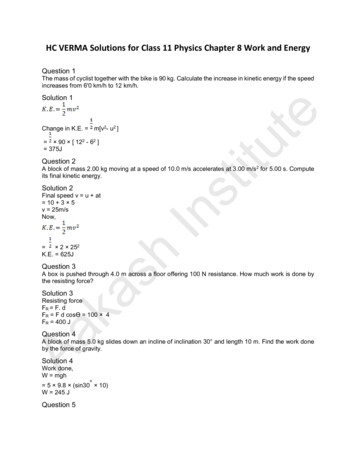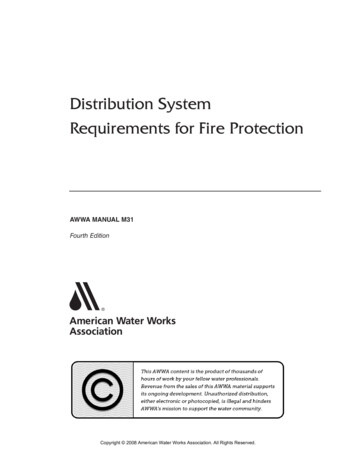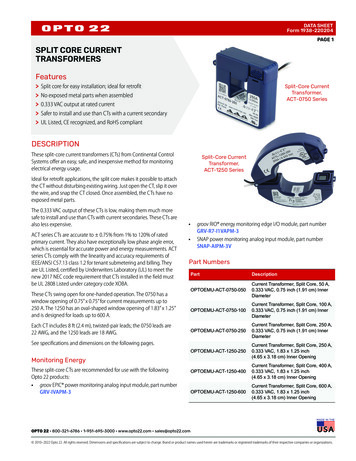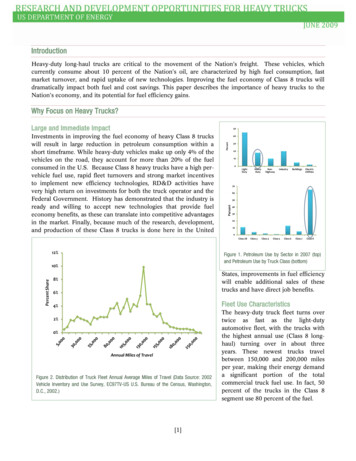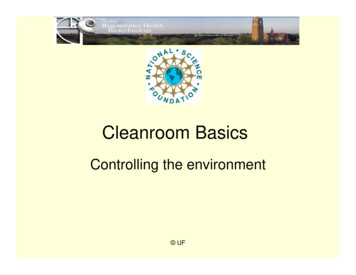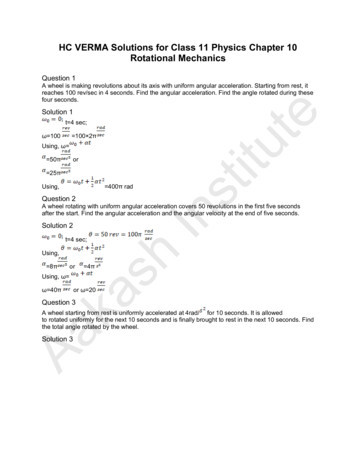
Transcription
HC VERMA Solutions for Class 11 Physics Chapter 10Rotational MechanicsQuestion 1A wheel is making revolutions about its axis with uniform angular acceleration. Starting from rest, itreaches 100 rev/sec in 4 seconds. Find the angular acceleration. Find the angle rotated during thesefour seconds.uteSolution 1t 4 sec;ω 100 100 2πUsing, ω ortit 50π 25π 400π radInsUsing,Question 2A wheel rotating with uniform angular acceleration covers 50 revolutions in the first five secondsafter the start. Find the angular acceleration and the angular velocity at the end of five seconds.Solution 2Using, 8πorUsing, ω 4πor ω 20kaω 40πsht 4 sec;Question 3AaA wheel starting from rest is uniformly accelerated at 4rad/ for 10 seconds. It is allowedto rotated uniformly for the next 10 seconds and is finally brought to rest in the next 10 seconds. Findthe total angle rotated by the wheel.Solution 3
θ 800 rad.uteAngular displacement Area under curvetitChapter 10 - Rotational Mechanics Exercise 196Question 4Solution 4ω 15 rad/sec; 1Substituting values in,Question 5shθ 100 radInsA body rotates about a fixed axis with an angular acceleration of one radian/second/second.Through what angle does it rotate during the time in which its angular velocity increases from 5 rad/sto 15 rad/s.Find the angular velocity of a body rotating with an acceleration of 2 rev/5th revolution after the start.kaSolution 5Aa; 2θ 5 rev 5 2π rad 10π radSubstituting values in,ω 4πω 2as it completes the;rad/secrev/secQuestion 6A disc of radius 10cm is rotating about its axis at an angular speed of 20 rad/s. Find the linear speedof(a) a point on the rim.(b) the middle point of a radius.Solution 6(a)v rω (0.1) (20)
v 2 m/s(b) v rω v 1 m/sQuestion 7A disc rotates about its axis with a constant angular acceleration of 4 rad/ . Find the radial andtangential accelerations of a particular at a distance of 1 cm from the axis end of the first secondafter the disc starts rotating.uteSolution 7; 4 rad/ ; t 1 secω tω 4 rad/secRadial acceleration Rtit (0.01) 16Tangential acceleration (0.01)(4) 0.04 4Question 8Ins 0.16AakaSolution 8shA block hangs from a string wrapped on a disc of radius 20 cm free to rotate about its axis which isfixed in a horizontal position. If the angular speed of the disc is 10 rad/s at some instant, with whatspeed is the block going down at the instant?Block speed Rim speed of the discv Rω (0.2)(10)v 2 m/s
Question 9Three particles, each of mass 200 g, are kept at the corners of an equilateral triangle of side 10cm.Find the moment of inertia of the system about an axis(a) joining two of the particles and(b) passing through one of the particles and perpendicular to the plane of the particles. mIns(a)tituteSolution 9 0.2 1.5(b)Kg 2 0.2Kg-Question 10sh 4kaParticles of masses 1 g, 2 g, 3 g, . . . . . . ., 100 g are kept at the marks 1 cm, 2 cm, 3 cm, . . . . . . .,100 cm respectively on a metrescale. Find the moment of inertia of the system of particles about aperpendicular bisector of the metre scale.Solution 10AaThe perpendicular bisector passes from 50cm mark. So, there will be 49 particles on LHS and 50particles on RHS.I (100) [ (100) []] gm-
I 0.43 kg/[ Sum of square of n natural numbers,]Question 11Find the moment of inertia of a pair of spheres, each having a mass m and radius r, kept in contactabout the tangent passing through the point of contact.uteSolution 11InstitBy parallel axis theorem,Question 12The moment of inertia of a uniform rod of mass 0.50 kg and length 1 m is 0.10 kgabout a lineperpendicular to the rod. Find the distance of this line from the middle point of the rod.kashSolution 12AaBy parallel axis theorem,0.1 X 0.34 mQuestion 13Find the radius of gyration of a circular ring of radius r about a line perpendicular to the plane of thering passing through one of its particles.Solution 13
utemtit k Question 14The radius of gyration of a uniform disc about a line perpendicular to the disc equals its radius. Findthe distance of the line from the centre.shka InsSolution 14 d Question 15AaFind the moment of inertia of a uniform square plate of mass m and edge a about one of itsdiagonals.Solution 15
uteandthe square becomes rod of side 'a'titIf we squeeze rod alongSo,By perpendicular axis theorem,Ins [ As square is symmetric]Question 16AakaSolution 16shThe surface density (mass/area) of a circular disc of radius a depends on the distance fromthe centre as p(r) A Br. Find its moment of inertia about the line perpendicular to the plane of thedisc through its centre.Surface density of disc is varying radially so considering an element of thickness 'dr' at a distance 'r'from center of disc.σ A Br dm (A Br)(2πrdr)
2 [A]Question 17Solution 17 mg () mg ()Torque acts perpendicular to plane of the motion.Question 18tituteA particle of mass m is projected with the speed u at an angle θ with the horizontal. Find the torqueof the weight of the particle about the point of projection when the particle is at the highest point.InsA simple pendulum of length l is pulled aside to make an angle θ with the vertical. Find themagnitude of the torque of the weight w of the bob about the point of suspension. When is the torquezero?AakashSolution 18Torque will be zero at the lowest point of suspension as θ will be zero.Question 19When a force of 6.0 N is exerted atto a wrench at a distance of 8cm from the nut, it is just ableto loosen the nut. What force F would be sufficient to loosen it if it acts perpendicularly to the wrenchat 16cm from the nut?
uteSolution 19Torque in both the cases will be equal()(8) (F)(16)F 1.6 NtitQuestion 20Solution 20shInsCalculate the total torque acting on the body shown in figure about the point O.kaTorque Consider anticlockwise torque as negative and clockwise torque as positive. (10) (4)-(15) (6) 5(0)-20(4)τ 0.54 N-m (anticlockwise direction)Question 21AaA cubical block of mass m and edge a slides down a rough inclined plane of inclination θ with auniform speed. Find the torque of the normal force acting on the block about its centre.Solution 21
ff mgThe normal contact will shift as block is not toppling.titSo,uteSince,acceleration 0 mgInsQuestion 22A rod of mass m and length L, lying horizontally , is free to rotate about a vertical axis throughits centre. A horizontal force of constant magnitude F acts on the rod at a distance of L/4 fromthe centre. The force is always perpendicular to the rod. Find the angle rotated by the rod during thetime t after the motion starts.kashSolution 22Torque τ FAaI Now,θ θ Question 23
A square plate of mass 120g and edge 5.0 cm rotates about one of the edges. If it has a uniformangular acceleration of 0.2 rad/ , what torque acts on the plate?so it will behave as rod N-mQuestion 24InsI titSqueeze rod along axis AuteSolution 23Solution 24shCalculate the torque on the square plate of the previous problem if it rotates about a diagonal withthe same angular acceleration.M.I. of square plate about its diagonal kaI 0.5 N-mQuestion 25AaA flywheel of moment of inertia 5.0 kgis rotated at a speed of 60 rad/s. Because of the friction atthe axle, it comes to rest in 5.0 minutes. Find (a) the average torque of the friction, (b) the total workdone by the friction and (c) the angular momentum of the wheel 1 minute before its stops rotating.Solution 25ω α (a)
5( ) -1 N-m(b) KE Iute 9 KJ(c)Angular momentumtitL I 5(12) 60Question 26km and its mass is 6.0 shSolution 26 ka kg.InsBecause of the friction between the water in oceans with the earth's surface, the rotational kineticenergy of the earth is continuously decreasing. If the earth's angular speed decreases by 0.0016rad/day in 100 years, find the average torque of the friction on the earth. Radius of the earth is 6400N-mChapter 10 - Rotational Mechanics Exercise 197AaQuestion 27A wheel rotating at a speed of 600 rpm (revolutions per minute) about its axis is brought to rest byapplying a constant torque for 10 seconds. Find the angular deceleration and the angular velocity 5seconds after the application of the torque.Solution 27
For t 5sec, 10 (-1)(5)Question 28uteA wheel of mass 10 kg and radius 20cm is rotating at an angular speed of 100 rev/min when themotor is turned off. Neglecting the friction at the axle, calculate the force that must be appliedtangentially to the wheel to bring it to rest in 10 revolutions.Solution 28titθ 10 rev 20π radω 0F (InsUsing,)( ) F 0.87 NQuestion 29kaSolution 29shA cylinder rotating at an angular speed of 50 rev/s is brought in contact with an identical stationarycylinder. Because of the kinetic friction, torques act on the two cylinders, accelerating the stationaryone and decelerating the moving one. If the common magnitude of the acceleration and decelerationbe one revolution per second square, how long will it take before the two cylinders have equalangular speed?Let after time 't' their angular velocity be 'ω'cylinder :-; α -1;Aaω ω 50-t -(i)cylinder :-α 1ω ω t -(ii)From (i) and (ii)ω 25 rev/sect 25 secQuestion 30A body rotating at 20 rad/s is acted upon by a constant torque providing it a deceleration of 2 rad/ .At what time will the body have kinetic energy same as the initial value if the torque continues to act?
Solution 30ω Now, wheel accelerates and when angular velocity becomes 20 rad/sec it will have same KE.ω ute20 0 T T 20 secQuestion 31InstitA light rod of length 1 m is pivoted at its centre and two masses of 5 kg ang 2 kg are hung from theends as shown in figure. Find the initial angular acceleration of the rod assuming that it washorizontal in the beginning.kashSolution 31N-m15 []αAaα 8.57Question 32Suppose the rod in the previous problem has a mass of 1 kg distributed uniformly over its length.(a) Find the initial angular acceleration of the rod.(b) Find the tension in the supports to the blocks of mass 2 kg and 5 kg.Solution 32(a)(50 0.5-20 0.5) [(2) 5 ]α
tituteα 8.1(b)InsNNQuestion 33kashFigure shows two blocks of masses m and M connected by a string passing over a pulley. Thehorizontal table over which the mass m slides is smooth. The pulley has a radius r and moment ifinertia I about its axis and it can freely rotate about the axis. Find the acceleration of the mass Massuming that the string does not slip on the pulley.AaSolution 33Mg- Ma -(i)-(ii)
-(iii)a rα -(iv)Solving , (i),(ii),(iii) and (iv)a Question 34InstituteA sting is wrapped on a wheel of moment of inertiaand radius 10cm and goes througha light pulley to support a ablock of mass 2.0kg as shown in the figure. Find the acceleration of theblockAakashSolution 34
utetitInsshkaAaQuestion 35Suppose the smaller pulley of the previous problem has its radius 5.0cm and momentof inertiaSolution 35. Find the tension in the part of the string joining the pulleys.
kaAashutetitIns
utetitInsshQuestion 36AakaThe pulleys in figure are identical each having a radius R and moment of inertia I. Find the accelerationof block M.Solution 36
utetitInsshkaAaQuestion 37The descending pulley shown in figure has a radius 20 cm and moment of inertia 0.20 kg- . Thefixed pulley is light and the horizontal plane frictionless. Find the acceleration of the block if its massis 1.0 kg.
Translatory Motion Equation-(i)IαI -(iii)kaFor mass mshmg-() m -(ii)Rotational Motion EquationInstituteSolution 37(0.2) m 10 kg -(iv)Using, (i),(ii),(iii) and (iv)Aaa 10 m/Question 38The pulley shown in figure has a radius 10 cm and moment of inertia 0.5 kgabout its axis.Assuming the inclined planes to be frictionless, calculate the acceleration of the 4.0 kg block.
uteSolution 38titHere,4g-(i)-(ii)Rotational Motion Equationa 0.25Question 39-(iii)shUsing (i),(ii) and (iii)InsI 0.5 kgR 0.1mTranslatory Motion EquationSolve the previous problem if the friction coefficient between the 2.0 kg block and the plane below itis 0.5 and the plane below the 4.0 kg block is frictionless.kaSolution 39Here, I 0.5 Kg; R 0.1 m ; ff Translatory Motion Equation4g-(i)Aa-(ii)Rotational Motion EquationUsing (i),(ii) and (iii)a 0.125Question 40(iii)
A uniform metre stick of mass 200 g is suspended from the ceiling through two vertical strings ofequal lengths fixed at the ends. A small object of mass 20 g is placed on the stick at a distance of 70cm from the left end. Find the tensions in the two strings.InsTranslatory Equilibrium EquationtituteSolution 40-(i)Rotational Equilibrium Equation at point Aclockwise Torque anticlockwise TorqueNFrom (i)Question 41sh(0.2g) (0.5) (0.02g)(0.7) (1)NA uniform ladder of length 10.0 m and mass 16.0 kg is resting against a vertical wall making ankaangle ofwith it. The vertical wall is frictionless but the ground is rough. An electrician weighing60.0 kg climbs up the ladder. If he stays on the ladder at a point 8.00 m from the lower end, what willbe the normal force and the force of friction on the ladder by the ground? What should be theminimum coefficient of friction for the electrician to work safely?AaSolution 41
ute(Horizontal direction)Ins(Vertical direction)titTranslatory Equilibrium EquationRotational Equilibrium at bottom of ladderClockwise Torque Anticlockwise Torque412 shSolving,Chapter 10 - Rotational Mechanics Exercise 198kaQuestion 42Suppose the friction coefficient between the ground and the ladder of the previous problem is 0.540.Find the maximum weight of a mechanic who could go up and do the work from the same position ofthe ladder.AaSolution 42
utetit-(i)InsHere ,Translatory Equilibriumsh- (ii)Rotational Equilibrium about point 'O'Solving (i),(ii) and (iii)m 44 kgkaQuestion 43-(iii)A 6.5 m long ladder rests against a vertical wall reaching a height of 6.0 m. A 60 kg man stands halfway up the ladder. (a) Find the torque of the force exerted by the man on the ladder about the upperend of the ladder. (b)Assuming the weight of the ladder to be negligible as compared to the man andassuming the wall to be smooth, find the force exerted by the ground on the ladder.AaSolution 43
utetitB 2.5 mτ 60g () 60g()N-m(Vertical Translatory Equation)ka(b)sh(a)InsBy Pythagoras theorem,AaRotational Equilibrium at OQuestion 44The door of an almirah is 6 ft high, 1.5 ft wide and weighs 8 kg. The door is supported by two hingessituated at a distance of 1 ft from the ends. If the magnitudes of the force exerted by the hinges onthe door are equal, find this magnitude.Solution 44
By translational Equilibriumitutest-(i)Rotational Equilibrium at point OInMagnitude of forces by hinges are equal.sh-(ii)-(iii)Solving (i),(ii),(iii)kaMagnitude of force 43 NQuestion 45AaA uniform rod of length L sets against a smooth roller as shown in figure. Find the friction coefficientbetween the ground and the lower end if the minimum angle that the rod can make with thehorizontal is θ.
Translatory equilibrium-(i)-(iii)Question 46sh-(iv)Solving (i),(ii),(iii) and (iv)In-(ii)Rotational Equilibrium about bottomstituteSolution 45kaA uniform rod of mass 300 g and length 50 cm rotates at a uniform angular speed of 2 rad/s aboutan axis perpendicular to the rod through an end. Calculate (a) the angular momentum of the rodabout the axis of the rotation, (b) the speed of the centre of the rod and (c) its kinetic energy.AaSolution 46(a) L Iω 0.05 kg(b) v Rω (0.25)(2)v 0.5 m/s
(c) KE KE 0.05 JQuestion 47ituteA uniform square plate of mass 2.0 kg and edge 10 cm rotates about one of its diagonals under theaction of a constant torque of 0.10 N-m. Calculate the angular momentum and kinetic energy of theplate at the end of the fifth second after the start.Solution 47τ Iα0.1 st0.1 [Inω ω 30 rad/secAngular momentum , L Iα]KE KE 75 JQuestion 48sh 0.5 kg-kaCalculate the ratio of the angular momentum of the earth about its axis due to its spinning motion tothat about the sun due to its orbital motion. Radius of the earth 6400 km and radius of the orbit ofthe earth about the sun 1.5 km.Solution 48AaIω ()( ) -(i)Iω Divide (i) by (ii)-(ii)
Question 49Two particles of massesandare joined by a light rigid rod of length r. The system rotates atan angular speed ω about an axis through the centre of mass of the system and perpendicular to thewill beDistance of COM fromL Iωwill be)ωL []InDistance of COM fromwhereQuestion 50shL is the reduced mass of thestSolution 49L (whereituterod. Show that the angular momentum of the system is L system defined askaA dumb-bell consists of two identical small balls of mass ½ kg each connected to the two ends of a50 cm long light rod. The dumb-bell is rotating about a fixed axis through the centre of the rod andperpendicular to it at an angular speed of 10 rad/s. An impulsive force of average magnitude 5.0 Nacts on one of the masses in the direction of its velocity for 0.10 s. Find the new angular velocity ofthe system.AaSolution 50τ IωF r 5(0.25) 2( )
τ 0.1τQuestion 51ituteA wheel of moment of inertia 0.500 kgand radius 20.0 cm is rotating about its axis at an angularspeed of 20.0 rad/s. It picks up a stationary particle of mass 200 g at its edge. Find the new angularspeed of the wheel.Solution 51Since ,]st(0.5)(20) [0.5 (0.2)Question 52InA driver having a moment of inertia of 6.0 kgabout an axis through its centre of mass rotates atan angular speed of 2 rad/s about the axis. If he folds his hands and feet to decrease the moment ofinertia to 5.0 kg-, what will be the new angular speed?Solution 52shSince,6(2) 5karad/secQuestion 53A boy is seated in a revolving chair revolving at an angular speed of 120 revolutions per minute. Twoheavy balls form part of the revolving system and the boy can pull the balls closer to himself or maypush them apart. If by pulling the balls closer, the boy decreases the moment of inertia of the systemto 2 kg-Aaby 6 kg-, what will be the new angular speed?Solution 53Since,6(120) (2) (rev/secQuestion 54A boy is standing on a platform which is free to rotate about its axis. The boy holds an open umbrellacoincides with that of the platform. The moment of inertia of " the platform plus the boy system" is 3.0
kgand that of the umbrella is 2.0kg- . The boy starts spinning the umbrellaabout the axis at an angular speed of 2.0 rev/s with respect to himself. Find the angular velocityimparted to the platform.Solution 54Since,itute0 0 -(i)So, Angular speed of umbrella with respect to boy will be in the opposite direction.Let angular speed of boy be ωNow,-2 In equation (i),0 strev/secQuestion 55Solution 55(0.1)(160) (300) (0.1 )(200)kakg-shTaking wheels as a systemInA wheel of moment of inertia 0.10 kgis rotating about a shaft at an angular speed of 160rev/minute. A second wheel is set into rotation at 300 rev/minute and is coupled to the same shaft sothat both the wheels finally rotate with a common angular speed of 200 rev/minute. Find the momentof inertia of the second wheel.Question 56AaA kid of mass M stands at the edge of a platform of radius R which can be freely rotated about itsaxis. The moment of inertia of the platform is I. The system is at rest when a friend throws a ball ofmass m and the kid catches it. If the velocity of the ball is v horizontally along the tangent to theedge of the platform when it was caught by the kid, find the angular speed of the platform after theevent.Solution 56
ituteConsidering ball, boy and platform as systemmvR [I (M m)]ωω stQuestion 57InSuppose the platform of the previous problem is brought to rest with the ball in hand of the kidstanding on the rim. The kid throws the ball horizontally to his friend in a direction tangential to therim with a speed v as seen by friend. Find the angular velocity with which the platform will startrotating.kashSolution 57Considering ball, boy and platform as system0 0 0 mvR I(-ω) (M)(- ω)Aaω Question 58Suppose the platform with the kid in the previous problem is rotating in anticlockwise direction at anangular speed ω. The kid starts walking along the rim with the speed v relative to the platform also inthe anticlockwise direction. Find the new angular speed of the platform.Solution 58Let angular velocity of platform after kid start running ω'So, angular velocity of kid with respect to earth ( ω' )
ω I ω' ω' ω-Chapter 10 - Rotational Mechanics Exercise 199Question 59ituteA uniform rod of mass m and length l is struck at an end by a force F perpendicular to the rod forshort time interval t. Calculate(a) the speed of the centre of mass, (b) the angular speed of the rod about the centre of mass, (c)the kinetic energy of the rod and (d) the angular momentum of the rod about the centre of mass afterthe force has stopped to act. Assume that t is so small that the rod does not appreciably change itsdirection while the force acts.Solution 59(a) F mastacceleration, a ; u 0; tv u atF( ) α .α;; t tαtshα (c) KE ka Inv (b) τ Iα(d) L I)Aa (L Question 60A uniform rod of length L lies on a smooth horizontal table. A particle moving on a table strikes therod perpendicularly at an end and stops. Find the distance travelled by the centre of the rod by thetime it turns through a right angle. Show that if the mass of the rod is four times that of the particle,the collision is elastic.Solution 60
ituteMomentum conservationmu 0 m(0) M(v)0 mu( ) (stv Angular Momentum conservation)ω 0ω InTime to rotate byω sht t distance travelled by roddistance speed timeka Aas Now, if M 4m then Hence proved.Question 61Suppose the particle of the previous problem has a mass m and speed v before the collision andsticks to the rod after the collision. The rod has a mass M. (a) Find the velocity of the centre of massC of the system constituting "the rod plus the particle". (b) Find the velocity of the particle withrespect to C before the collision. (c) Find the velocity of the rod with respect to C before the collision.
(d) Find the angular momentum of the particle and of the rod about the centre of mass C before thecollision. (e) Find the moment of inertia of the system about the vertical axis through the centre ofmass C after the collision. (f) Find the velocity of the centre of mass C and the angular velocity of thesystem about the centre of mass after the collision.ituteSolution 61mv (M m)v'Inv' (b) velocity of the particle with respect to COM v-v' v-sh st(a)ka(c) velocity of the rod wrt the centre of mass (d) Distance of COM from the particleAngular momentum of body about COM mvr mAa Angular momentum of rod about COM M (e) M.I. about COM I mI (f) About COM
Iω mvr ω Question 62ituteTwo small balls A and B, each of mass m, are joined rigidly by a light horizontal rod of length L. Therod is clamped at the centre in such a way that it can rotate freely about a vertical axis through itscentre. The system is rotated with an angular speed ω about the axis. A particle P of mass m kept atrest sticks to the ball A as the ball collides with it. Find the new angular speed of the rod.Solution 62 [M]ω [3m] ω'ω' stQuestion 63Two small balls A and B, each of mass m, are joined rigidly by a light horizontal rod of length L. TheshInsystem translates on a frictionless horizontal surface with a velocityin a direction perpendicular tothe rod. A particle P of mass m kept at rest on the surface sticks to the ball A as the ball collides withit. Find(a) the linear speeds of the balls A and B after the collision, (b) the velocity of the centre of mass Cof the system A B P and (c) the system about C after the collision.[Hint: The light rod will exert a force on the ball B only along its length.]Solution 63ka(a) The light rod will exert a force on the ball B only along its length. So collision will not effect itsvelocity.Momentum conservation for ball A 2mAam(b)
st(c) velocity of A with respect to centre of mass velocity of B with respect to centre of mass ) (mQuestion 64) [2mInApplying, m(2mitute ]kashSuppose the rod with the balls A and B of the previous problem is clamped at the centre in such away that it can rotate freely about a horizontal axis through the clamp. The system is kept at rest inthe horizontal position. A particle P of the same mass m is dropped from a height h on the ball B.The particle collides with B and sticks to it. (a) Find the angular momentum and the angular speed ofthe system just after the collision. (b) What should be the minimum value of h so that the systemmakes a full rotation after the collision.AaSolution 64(a) If we consider two bodies P and B as systemthenm(v' and) 2mv'
m(mL)( ) Iω ()ωituteω (b) When the mass 2m and m are at the top most position and at the lowest point respectively, theywill automatically rotate.Change in Potential Energy Change in kinetic Energy2mg( )-mg( ) Img( ) h Question 65stTwo blocks of masses 400 g and 200 g are connected through a light string going over a pulleywhich is free to rotate about its axis. The pulley has a moment of inertia 1.6and aradius 2.0 cm. Find (a) the kinetic energy of the system as the 400 g block falls through 50 cm, (b)the speed of the blocks at this instant.AakashInSolution 65Translatory Motion Equation0.4g- 0.4a -(i)-0.2g 0.2a -(ii)Rotational Motion Equation,
Solving (i),(ii) and (iii)a g/5-(iii)Speed of block itute 1.4 m/sTotal kinetic energy of system 0.98 JQuestion 66stThe pulley shown in figure has a radius of 20 cm and moment of inertia 0.2 kg- . The string goingover it is attached at one end to a vertical spring of spring constant 50 N/m fixed from below, andsupports a 1 kg mass at the other end. The system is released from rest with the spring at its naturalSolution 66shInlength. Find the speed of the block when it has descended through 10 cm. Take g 10 m/ .By energy conservationmgh ka1v 0.5 m/sQuestion 67AaA metric stick is held vertically with one end on a rough horizontal floor. It is gently allowed to fall onthe floor. Assuming that the end at the floor does not slip, find the angular speed of the rod when ithits the floor.Solution 67
ituteBy energy conservationmgmgstω 5.42 rad/secQuestion 68AakaSolution 68shInA metre stick weighing 240 g is pivoted at its upper end in such a way that it can freely rotate in avertical plane through the end. A particle of mass 100 g is attached to the upper end of the stickthrough a light string of length l m. Initially, the rod is kept vertical and the string horizontal when thesystem is released from rest. The particle collides with the lower end of the stick there. Find themaximum angle through which the stick will rise.Velocity of ball just before the collision:-u u u m/secNow, Torque about hinge is zero
mul 0 Iω(0.1) ((0.1) [(0.1))ω]ωituteω Now, By energy conservationQuestion 69stA uniform rod pivoted at its upper end hangs vertically. It is displaced through an angle ofandthen released. Find the magnitude of the force acting on a particle of mass dm at the tip of the rodwhen the rod makes an angle ofwith the vertical.kashInSolution 69AaBy energy conservationSo, centrifugal force Let angular acceleration of the rod be α when it makes an angle ofτ Iαmg() with the vertical.
α 0.9( )So, tangential force ituteSo,Question 70A cylinder rolls on a horizontal plane surface. If the speed of the centre is 25 m/s, what is the speedof the highest point?For pure rollingshSpeed at highest point v 2v 2(25) 50 m/sInstSolution 70Chapter 10 - Rotational Mechanics Exercise 200Question 71kaA sphere of mass m rolls on a plane surface. Find its kinetic energy at an instant when its centremoves with speed v.Solution 71v Rω (Pure rolling)AaK.E K.E Question 72A string is wrapped over the edge of a uniform disc and the free end is fixed with the ceiling. Thedisc moves down, unwinding the string. Find the downward acceleration of the disc.Solution 72
From (i) and (ii)itutestmg-T ma -(i)τ Iα-(ii)Ina Question 73kaSolution 73shA small spherical ball is released from a point at a height h on a rough track shown in figure.Assuming that it does not slip anywhere, find its linear speed when it rolls on the horizontal part ofthe track.By energy conservation,mgh Aamgh Question 74A small disc is set rolling with a speed v on the horizontal part of the track of the previous problemfrom right to left. To what height will it climb up the curved part?Solution 74By energy conservation,
Question 75A sphere starts rolling down an incline of inclination θ. Find the speed of its centre when it hascovered a distance l.Question 76shBy energy conservation,InstituteSolution 75kaA hollow sphere is released from the top of an inclined plane of inclination θ. (a) What should be theminimum coefficient of friction between the sphere and the plane to prevent sliding? (b) Find thekinetic energy of the ball as it moves a length l on the incline if the friction coefficient is half the valuecalculated in part (a).AaSolution 76
(a)-(i)-(ii)itute-(iii)Solving (i),(ii) and (iii)(b)InstTranslatory Motion EquationshTime to travel ,AakaRotational Motion EquationK.E K.E Question 77A solid sphere of mass m is released from rest from the rim of a hemispherical cup so that it rollsalong the surface. If the rim of the hemisphere is kept horizontal, find the normal force exerted by thecup on the ball when the ball reaches the bottom of the cup.Solution 77
ituteBy conservation of energyInstNormal contact at bottomQuestion 78AakaSolution 78shFigure shows a rough track, a portion of which is in the form of a cylinder of radius R. With whatminimum linear speed should a sphere of radius r be set rolling on the horizontal part so that itcompletely goes round the circle on the cylindrical part.
ituteQuestion 79shNow, by energy conservationInstFor minimum u, the ball will just be in contact with surface at top. So, N 0AakaFigure shows a small spherical ball of mass m rolling down the loop track. The ball is released onthe linear portion at a vertical height H from the lowest point. The circular part shown has a radius R.(a) Find the kinetic energy of the ball when it is at a point A where the radius makes an angle θ withth
A rod of mass m and length L, lying horizontally , is free to rotate about a vertical axis through its centre. A horizontal force of constant magnitude F acts on the rod at a distance of L/4 from the centre. The force is always perpendicular to the rod. Find the angle rotated by the rod during the




